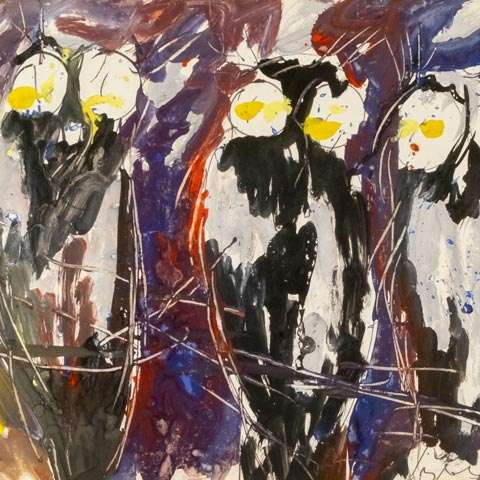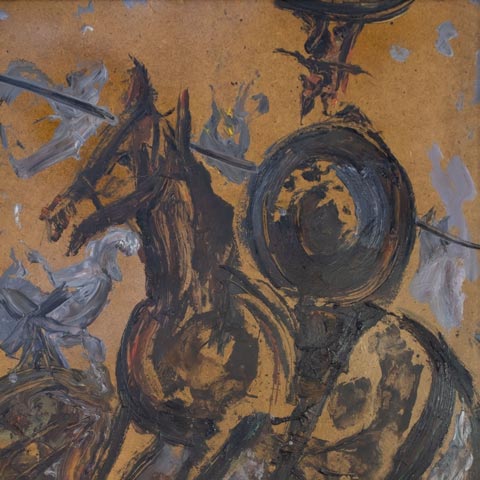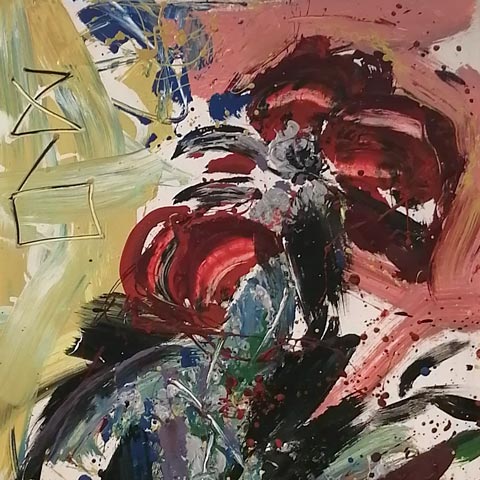
A virtuoso capable of creating a masterpiece in a matter of minutes using a simple set of paints, a couple of cigarette butts and leftover snacks. An outstanding improviser. A brilliant representative of the underground art, forever persecuted by the monstrous Soviet laws. The kind of person who never went to the trouble. But if they press, then hold on. Are they demanding to appear on the carpet to the almighty Minister Furtseva? Okay, I'll come in rags and with crumpled newspapers sticking out of holes. So that they'll let me go right away. Who is this Zverev anyway? A freak? A buffoon? Or a subtle fronder, provoking the authorities and functionaries from culture?
Today his works are in great demand. Zverev's craftsmanship is admired by the third generation of collectors. His exhibitions are still sold out. Memoirs and monographs are published. Dozens of buyers are competing for his works at auctions. There is a whole private museum named after him in Moscow. Zverev, like 60 years ago, is a legend, a phenomenon and pride. Only no longer in the narrow circle of “friends”, but on a national scale.
However, it would be a mistake to think that everyone just loves him. For those who do not tolerate otherness, Zverev is simply an odious figure. A restless, always drunken vagabond, wandering through other people's homes, and feasts. A rowdy in untidy clothes, who preferred to sleep on the floor by the radiator on a newspaper. A man with a “license”, who stuffed newspaper up his sleeves in the cold and wore his shirts inside out with the seams facing down. A hard-drinking artist who had never fully realized his talent. A pauper. And that's why he painted his portraits for a ruble or three-ruble bill, to squander it on booze and a simple snack. You can argue with them for a long time, but you will not be cute forcibly.
Those who knew the artist personally advise against taking what you read in the memoirs at face value. They warn that Zverev was an artistic person. He loved his audience and reincarnated in its presence. Therefore much in Zverev's performance should be regarded as a performance, a happening. And a smokescreen. They add that in spite of his conspicuous quirks, Zverev was quite on his mind. And certainly not as simple as he seemed. His dusty, paint-stained clothes were an expensive specialty, donated by his patron Kostaki and foreign collectors. The tramp's coats were better and more expensive than those of most Soviet dudes. And some of his customers were so generous that he left them with bundles of bills in his pockets. Zverev could afford to take cabs “to the bakery” and other places. Zverev's savings accounts, which were kept by his friend and executor Igor Kuznetsov, contained tens of thousands of Soviet rubles. At least from Oksana Aseeva for the sold cottage on Nikolina Gora. In a word, the beggar artist did not just have money, he was wallowing in money. It is clear that in the USSR, even with a lot of money, there was nowhere to go around especially. But there was certainly no need to be poorly dressed, spend nights at his friends, and to paint to order for food.
Then what was it? And what was it for?
The nomadic life and individual quirks of the artist can be explained by the traces of a mental disorder (the legendary suspiciousness, the shirts inside out with the seams facing out, and the wiping with vodka — these are not just for fun). But more often, Zverev's outlandish behavior was an element of playing within the role chosen by the artist. Friends of the artist not without reason pay attention to the fact that his way of life was a kind of protection from persecution. Sometimes imaginary, sometimes real. For example, Zverev really panic-stricken fear of the police. And not without reason: they would take him again and beat him up again. Or even take to jail. Paradoxically, one of our major artists of the second half of the 20th century was considered not an artist by Soviet law, but a parasitic slacker. Zverev was not a member of the Union of Artists. Which meant that he could be sued under Article 209 at any time. After that, he could end up in jail, in a penal colony, in compulsory treatment, whatever. The sword of “parasitism” hung over Zverev most of his life, at least until the mid-1970s. Only after the organization of the City committee of graphic arts on Malaya Gruzinskaya Street Vladimir Nemukhin gave Zverev the coveted “crust” of a member of the City committee. Things became calmer with it. But it was not only about “loafing”. Many other dangers threatened the artist. Historically, Zverev's customers were foreigners, ambassadors and diplomats. There were situations when diplomats smuggled him into embassies for sessions. He could also be “taken on the pencil” for this. So it was better to hide, to pretend, to fool around. That's what he did. He disappeared, covered his tracks, “lay low”. He was “buried” several times. A rumor “Zverev died” was periodically circulated in Moscow. But he “resurrected” as if nothing had happened. Today such behavior would be called reasonable social camouflage. But back then his actions looked provocative and caused a lot of trouble for those around him.
Alas, behind tales of Zverev's strangeness and worldly “exploits” the new generation of collectors risks missing the main thing. For all his human complexity and creative irregularity, Zverev was really an exceptional talent. Nugget. What is called, the artist from God. That are born once every 100 years. In the 1950s, Zverev was capable of drawing for hours and reaching a literal physical ecstasy in the process. It is not without reason that he is considered a virtuoso, a master of sketching and rapid drawing. Yes, in his work there were both failures and passing things. But what masterpieces came out from under his brush! In 1950–1960-ies in the prime of strength Zverev was able to work wonders. And even if there were fewer masterpieces by the end of his life, they still appeared. Speaking of which, I still believe that the “watershed” of 1966 (they say, after that year Zverev began to paint worse, for the public's consumption) is nothing more than a hoax invented by people who were offended by the artist. And it was also repeated by Zverev himself as a kind of bravado: “I used to draw for myself, but now I have turned into a "people's" artist”. Personally, I find no justification for such a sharp division into “before” and “after”.
Nevertheless, formal liquidity criteria and market benchmarks have already been established. You can agree or disagree with this “public opinion”. But if you buy with an investment in mind, you have to take it into account. In particular, the year of creation, in fact, really affects the price and liquidity. Zverev's period in the late 1950s and early 1970s is considered particularly valuable. And “late Zverev” (the artist died in 1986) is valued less. Nevertheless, I'd like to repeat that in the first place I'd advise to pay attention not to the year of the work's creation, but to its energy, inspiration and quality.
With this in mind, what priorities should collectors and investors set? What should be hunted for in the first place?
- Paintings on especially popular subjects: Don Quixotes, pines on Nikolina Gora, flowers, animals. Any of these subjects is capable of causing a serious struggle among the discerning public. Don Quixote is a romantic image of the misunderstood loner to whom the artist compared himself. Nikolina Gora is a country place, where the house of his muse, Oksana Aseeva, was. Flowers by Zverev occur simply fantastic beauty, but he wrote them, alas, rarely. As for animals, this is also an old passion of Zverev, even from the Palace of Pioneers. He spent many days at the zoo, admiring the grace of our smaller brothers, catching interesting moments. It is no coincidence that his paintings of animals came out very inspired, with character.
Today the painted Don Quixotes by Zverev can cost in the range of $ 10,000–25,000. Large views of Nikolina Gora — $ 20,000–30,000. Or maybe even more — they are scarcely in sight. Painted flowers and animal paintings can cost in the region of $ 15,000. All these subjects are rare and need to be “caught”.


- Painted portraits. This is Zverev's signature format, his most recognizable genre. Many artists have tried to imitate Zverev's characteristic portrait manner. In fact, most of the fakes on the market are portraits “like Zverev”. Nevertheless: a good Zverev female portrait in oil quickly finds its buyer in the price range of 6,000–8,000 dollars. Portraits of famous people and the muse Oksana Aseyeva are more expensive than others. They are also the most liquid. High-quality male portraits are cheaper, starting at $ 5,000.

- Zverev's collaborative works. Co-authored paintings by Zverev are rare on the market. Some, for example those painted together with Arseny Sedugin, I have not seen for many years on sale at all. But they do exist. Zverev's works, painted together with the artists Gino Sinigaglia and Victor Kazarin, friends in the Gorkom, are well known. Paintings by Zverev-Kazarin are more common than others. In addition, they are best catalogued because they participated in posthumous exhibitions “Zverev-Kazarin”. Anatoly Timofeevich Zverev lived and worked in the apartment of his friend Victor Semyonovich Kazarin in 1986. Together they wrote a cycle of large paintings, signed KAZ or KZ. These are one and a half to two meter long pieces. Zverev had never painted anything this big before he met Kazarin. For him it was an adventure, a new experience. The paintings turned out to be inspirational, powerful — among them there are also unconditional masterpieces. Alas, Kazarin is no longer alive either. Victor Semyonovich died a month ago. And the joint paintings live in private collections, sometimes go to the auctions. Today, for one and a half meter canvases they ask in the region of $ 8,000–10,000.

- Graphics of the late 1950s — 1970s on the already mentioned especially popular subjects — with Don Quixotes, landscapes, still lifes, and genre scenes. Drawings of the “avant-garde cycle” — with geometry in the language of Suprematism, fall into the same category. Particularly successful large drawings by Anatoly Timofeevich today can cost $ 7,000–10,000. That is, one and a half times more expensive than oil portraits. And they can be sold quite quickly — a wide base of collectors provides demand. Please note that all of the above is true only for particularly successful drawings, and not for any graphics in general.
- Small drawings and “quick” graphic portraits. During the time of the City committee of graphic artists, Zverev drew portraits of exhibition visitors in three minutes. It was a kind of recklessness, a gimmick for the astonished audience. But it often came out very talented. His pencil and watercolor portraits, for which he was paid a ruble or three, are worth between 20,000 and 120,000 rubles today. But I do not intentionally translate into dollars, because it is unlikely that these ruble prices will adjust with the exchange rate. Zverev's simple drawings are recognizable, decorative, and sometimes they are a real decoration of a collection. But they are less suitable for investment than all of the above categories. In principle, you can already guess this from the price. The exception is Zverev's illustrations to the works of his favorite writers and poets: Gogol, Lermontov, etc. This is a special genre, they have their own collectors and their own pricing rules. The investment potential of “book” graphics is higher than that of ordinary graphics. But, alas, it does not even come close to painting.
Well, that's enough information for the first time.
And now for the most important and most valuable advice. Don't buy any Zverev without Valery Silaev's ironclad expertise. And buy only from proven places. No “profitable” purchases at little-known foreign auctions with the reasoning “fools, they just don't know that Zverev is expensive in Russia”. No buying from hand on Internet classifieds with the hope of “what if it really is Zverev?” God forbid. Remember that Anatoly Timofeevich is the most counterfeited Russian artist. And the crooks just adore unscared “smart people” who want to buy and speculate quickly.
In summary, the algorithm for a proper purchase would be as follows. You need: the right place — expertise — oil — a sought-after subject — a strong level of painting — a good size — a good year.
If you have to overpay for the whole set, that's okay. A good thing will grow in price and it will not be difficult to sell it later. Advice: if you meet a great work — take it, do not save much. Then you will remember us with a kind word.
Vladimir Bogdanov, specialist of the auction of Russian paintings and graphics ArtSale.info
Watch a video review of investing in the works of Anatoly Zverev on our YouTube channel:
- Log in to post comments










